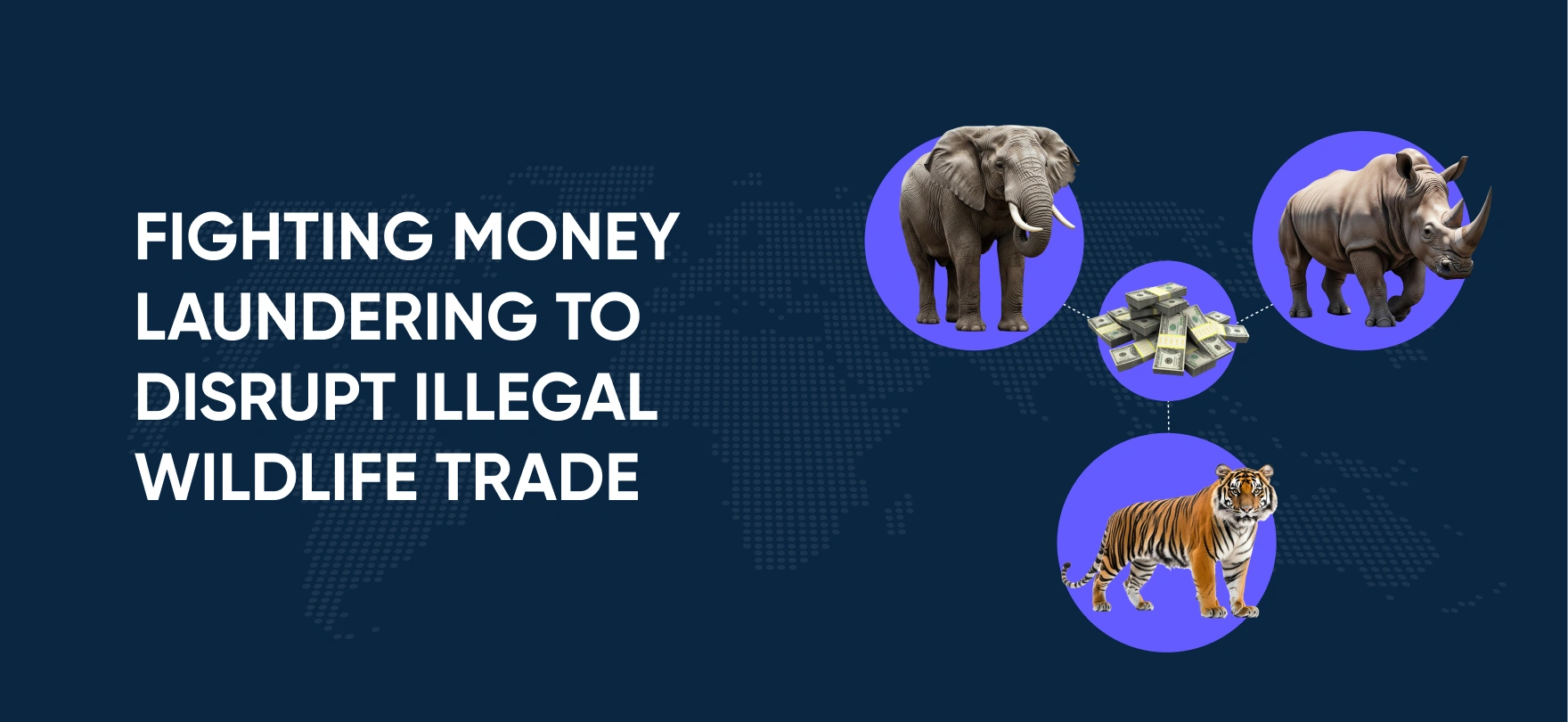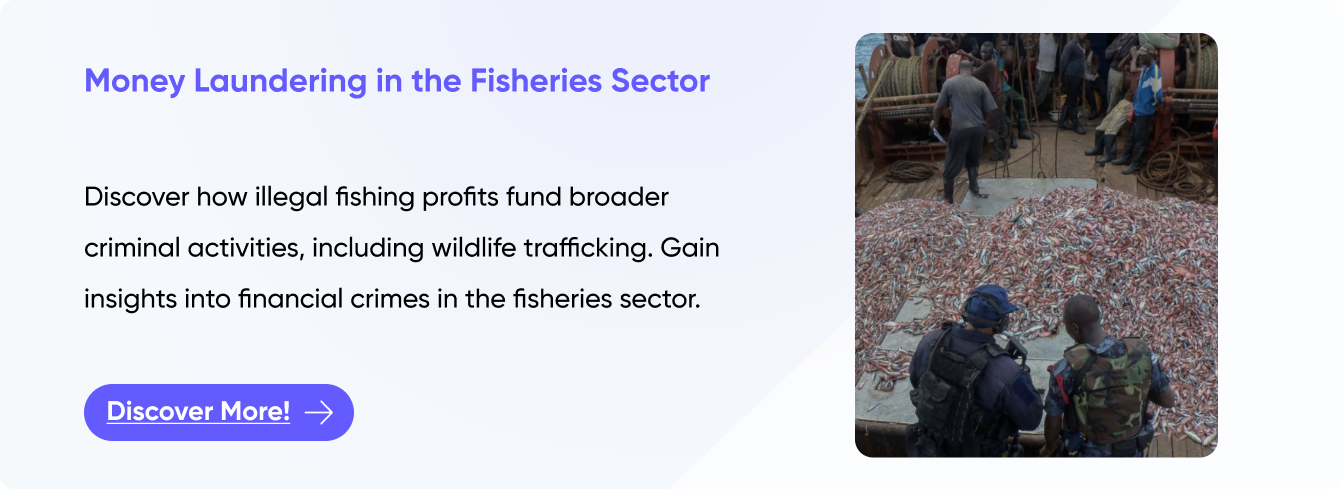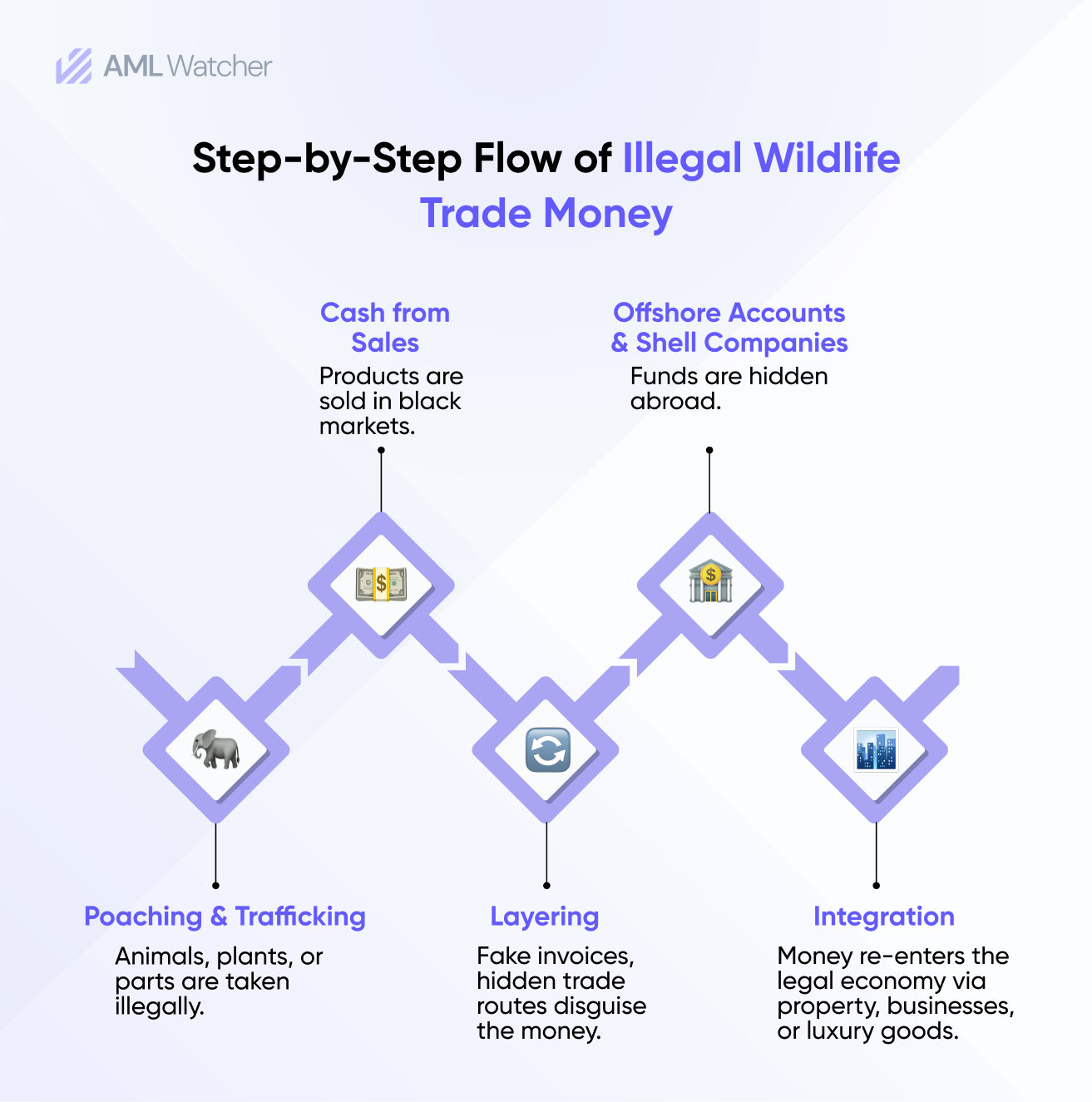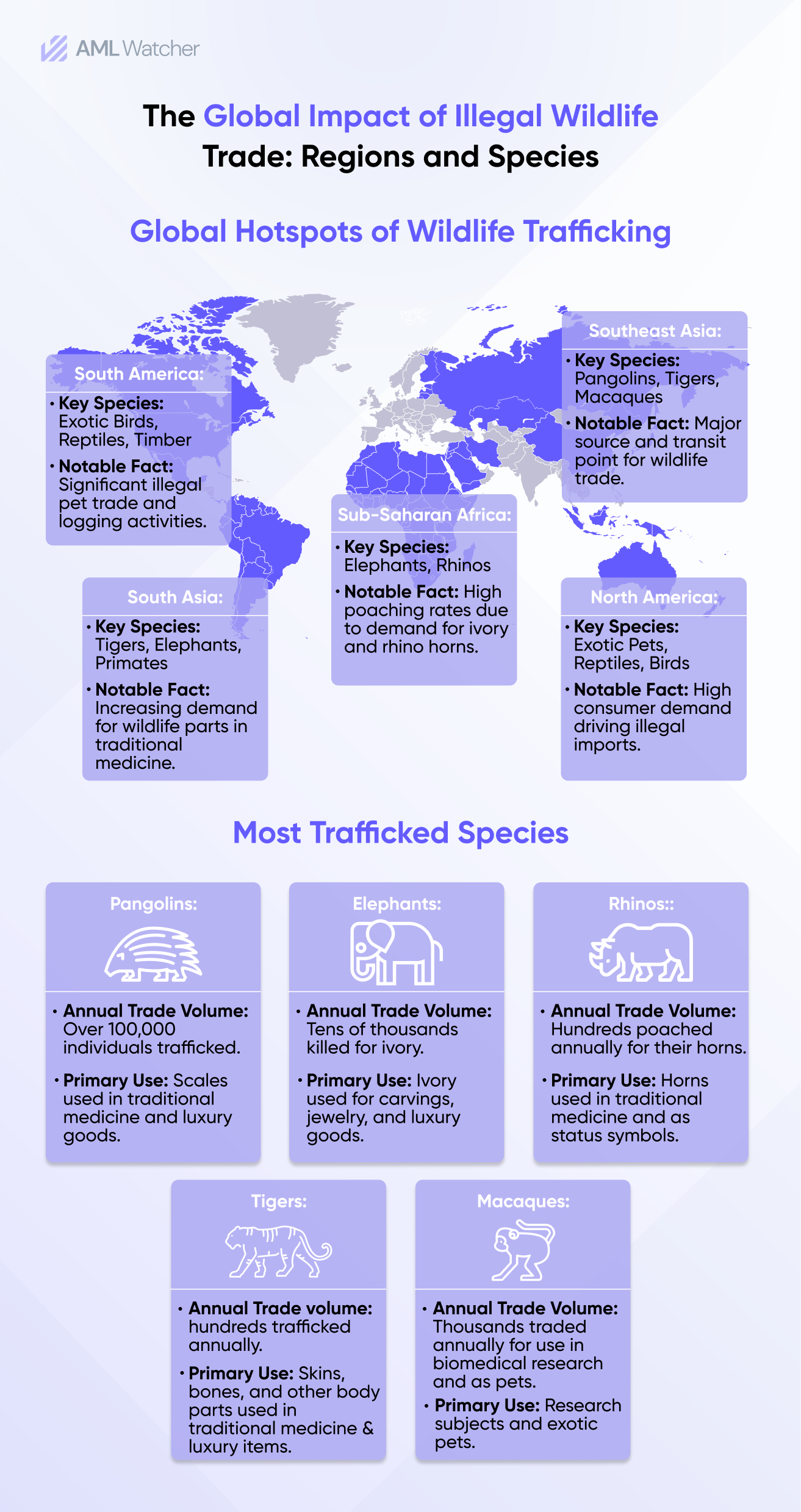
Fighting Money Laundering To Disrupt Illegal Wildlife Trade
Criminals see wildlife not as living beings but as assets, and they are cashing in billions through a market worth up to $23 billion annually. This staggering black-market economy places illegal wildlife trade among major transnational crime sectors.
It also raises a critical question: What is a wildlife crime? And how are its illicit proceeds laundered into the legitimate financial system?
What Is Illegal Wildlife Trade?
Illegal wildlife trade involves unlawful poaching, harvesting, and exchange of protected animals, plants, or their derivatives, including ivory, rare timber, exotic pets, and more.
The United Nations Office on Drugs and Crime (UNODC) defines wildlife trafficking as “the illegal trade, smuggling, poaching, capture or collection of endangered species, protected wildlife, their derivatives or by-products”.
This black market targets over 4,000 plants and animal species worldwide, including iconic mammals as well as reptiles, birds, and rare flora, fueling a multi-billion-dollar underground industry. The illegal wildlife trade threatens biodiversity and pushes many species toward extinction, all while generating huge profits for traffickers and associated criminal networks.
Why are Criminals Attracted to Wildlife Trafficking?
Criminals are drawn to animal trafficking due to its low-risk and high-reward. Demand for luxury goods, exotic pets, and traditional medicine drives the trade, while weak laws and corruption in source regions make it easy to operate.
The United Nations and FATF classify wildlife smuggling as a significant organized crime with clear links to other criminal activities, from fraud and tax evasion to corruption, violence, and even terrorism financing.
What are the AML Compliance Challenges in Illegal Wildlife Trafficking?
Detecting and curbing illegal wildlife trading is quite a challenging task for regulators and AML compliance officers. During this process, compliance teams face numerous difficulties when dealing with wildlife trafficking related money laundering:
Overlooked Risk & Limited Awareness
Wildlife trafficking has long been overlooked in financial crime programs. Unlike drug or fraud cases, banks rarely train their staff to spot it. As a result, suspicious wildlife-linked transactions often go unnoticed, and law enforcement rarely follows the money.
FATF’s “Money Laundering and Illegal Wildlife Trade” report noted that countries and the private sector were not prioritising efforts to trace and combat financial flows from this trade in line with the risk. The result is a knowledge gap.
“Until recently, many compliance officers were unaware of what suspicious activity to look for, causing risk signals to be missed.”
FinCEN’s analysis of SAR data, in Illicit Finance Threat Involving Wildlife Trafficking report, found just 212 wildlife-trafficking-related SARs filed between January 2018 and October 2021, with an estimated 73 filings for 2021, low relative to the assessed scale of the problem.
Illegal Trade Hidden in Legal Business
Criminals mask contraband as legitimate commodities or commingle proceeds with genuine trade flows, making payments appear ordinary.
For example, ivory may be declared as wood carvings, or exotic animals may be labeled as tropical fish. Similarly, timber trafficking shares similar tactics in hiding illicit activities. This mix of legal and illegal trade makes it very hard for banks to identify suspicious payments.
A well-documented case illustrates this risk. In the U.S. Department of Justice (DOJ) report Stopping the Money Flow: The War on Terror Finance, Joseph Chait of the I.M. Chait Gallery conspired to smuggle nearly $1 million in rhino horn and ivory by falsifying customs forms, labeling items as “wood” or “plastic,” and undervaluing them.
The case was investigated under Operation Crash by the U.S. Fish & Wildlife Service (FWS), in coordination with the U.S. Attorney’s Office for the Southern District of New York and the U.S. Department of Justice. Chait pled guilty in 2016 and was sentenced to one year in prison and fined $10,000.
Such commingling of illegal and legal goods and funds means suspicious payments don’t always set off obvious alarms; they blend into the noise of genuine commerce.
Limited Warning Signs for Banks
Because illegal wildlife trade is hidden inside legal trade, banks have few clear warning signs to follow. Only recently have regulators started sharing indicators like unusual trade routes or repeated payments to exotic pet shops.
In June 2021, FinCEN issued Advisory FIN-2021-A003 on Environmental Crimes and Associated Illicit Financial Activity, which highlighted wildlife trafficking as a key concern and provided red-flag indicators to support SAR filings.
Similarly, FATF’s 2020 study outlined risk indicators, such as mis-declared goods, unusual trade routes, or clients tied to zoos, pet shops, and exotic medicine. But awareness is still limited.
Most compliance teams don’t yet have models to spot wildlife-related payments, and standard monitoring rules built for drugs, fraud, or human trafficking often miss transactions like repeated payments to wildlife parks or taxidermy exporters.
Even with new advisories in place, banks still face a gap. Without clearer typologies, it is hard for compliance teams to turn guidance into effective monitoring, so wildlife-linked transactions often slip through.
Cross-Border Complexities
Wildlife trafficking moves money across many countries, often through places with weak financial rules. Because banks and regulators do not always share information, it is difficult to see the whole money trail and stop laundering. Traffickers often move money through countries that have weak financial controls or use offshore shell companies to hide the true owners. At the same time, poor communication between governments and agencies hinders an effective response.
Wildlife crime investigators and financial intelligence units historically operated in silos, making it rare to “follow the money” of wildlife cases across borders.
FATF has urged authorities to improve coordination between wildlife crime enforcement and financial investigators, and to cooperate with other jurisdictions and the private sector, implying that such collaboration is still nascent.
Likewise, within the banking sector, a lack of data sharing means one bank might see part of a laundering network (e.g., funds entering a local account) but not the full picture if the funds quickly move abroad.
As the World Wildlife (WWF) report Targeting Natural Resource Corruption noted, if illicit proceeds stay in local banks and cash channels, global banks and FIUs may have no visibility. Traffickers exploit this by breaking transactions into pieces across countries and payment types (bank transfers, money remitters, mobile money, etc.) to avoid any single point seeing the whole chain.
In short, the Cross-border financial flows remain fragmented, making it hard for compliance teams to connect the pieces, especially with weak intelligence-sharing systems.
These challenges show why it is hard to discover and stop money laundering connected to the illegal wildlife trade. The good news is that awareness is rising and global regulators now recognize “nature crimes” as an AML priority, and efforts are underway to plug these gaps.
Next, we look at some real-world cases that show how wildlife traffickers move their money, and where financial controls have failed or succeeded.
Recent Enforcement Actions Against Wildlife Trafficking
Wildlife trafficking cases show how criminals move illicit profits and how authorities fight back.
INTERPOL’s Operation Thunder 2024 united 138 countries, leading to 2,213 seizures, 20,000 animals rescued, 365 arrests, and exposure of six criminal networks and 100 front companies. It revealed how traffickers use fraudulent paperwork, shell firms, and logistics providers to disguise payments as routine trade.
In the U.S., Operation Crash dismantled a $75M rhino horn ring with 41 arrests and 30 convictions. Criminals laundered proceeds through bulk cash, antiques dealers, and falsified customs forms, proving financial investigations can expand cases and seize assets.
Other cases include “Doc” Antle, who misused a charity to launder wildlife sales, and an Asian syndicate that used underground banking, rare currencies, and gold.
The Rathkeale Rovers case involves an Irish organized crime group that smuggles rhino horns. This group trafficked rhino horns to Europe, often stolen from museums and private collections.
The Sinaloa Cartel case, where a Mexican drug cartel is involved in trading fish bladders that are smuggled to China and sold for thousands of dollars.
To perform the illegal activities mentioned above, wildlife traffickers usually bribe the customs officers, park rangers, and those who are in control of transferring their goods, fueling corruption across the trade network.
The urgency is clear:
Illicit wildlife trafficking is not just a conservation issue; it also involves other monetary crimes like money laundering and drug trafficking, which can weaken the overall financial system and threaten overall security.
Recognizing these patterns, the FinCEN, FATF, and the Egmont Centre of FIU Excellence and Leadership (ECOFEL) have issued red-flag indicators to help banks detect such schemes, highlighting the need for stronger AML tools and cross-border intelligence.
Practical red flags and controls for banks
Use these signals to sharpen detection and escalate reviews:
- Commodity and paperwork anomalies: Goods inconsistent with a client’s profile, unusual HS codes, repeated amendments, or invoices that do not match bills of lading or inspection reports.
- Trade routing outliers: Indirect routes through jurisdictions with limited wildlife enforcement or weak AML regimes; sudden use of high-risk free-trade zones.
- Counterparty profiles: Links to zoos, exotic pet shops, taxidermists, and curio dealers where activity or volumes do not fit the stated business.
- SAR filing discipline: Apply FinCEN’s environmental crimes notice instructions and key terms so SARs are findable and useful to investigators.
Expose Hidden Wildlife Finance Networks with AML Watcher
AML Watcher’s proprietary AML data and screening capabilities help compliance teams surface wildlife-linked risk faster and with less noise:
- Real-time transaction monitoring flags anomalous flows before they clear, supplemented by custom risk scoring to spotlight unusual trades.
- Adverse media screening covers 415+ risk categories and predicate offenses, including wildlife trafficking.
- Customizable risk scoring tunes individual risk scores and lists to reflect wildlife-specific exposure and typologies identified by FATF and FinCEN
- Broad-spectrum screening against 3,500+ official watchlists and extensive global media sources that uncovers hidden wildlife-finance signals.
- Advanced network analysis maps ownership chains of suspicious actors, and enhanced trade surveillance monitors cross-border transactions for illicit patterns.
Get in touch with AML Watcher to map wildlife-linked exposure in your portfolio and calibrate controls accordingly.
We are here to consult you
Switch to AML Watcher today and reduce your current AML cost by 50% - no questions asked.
- Find right product and pricing for your business
- Get your current solution provider audit & minimise your changeover risk
- Gain expert insights with quick response time to your queries








